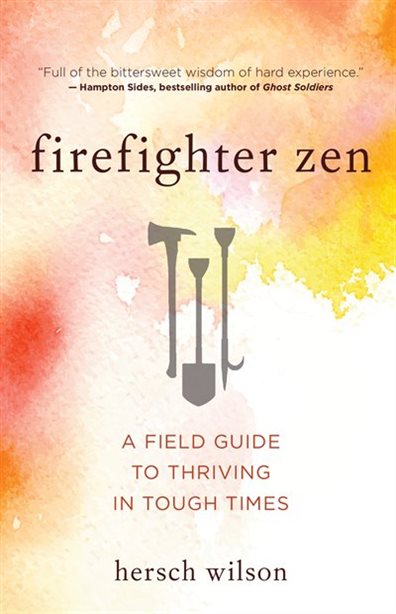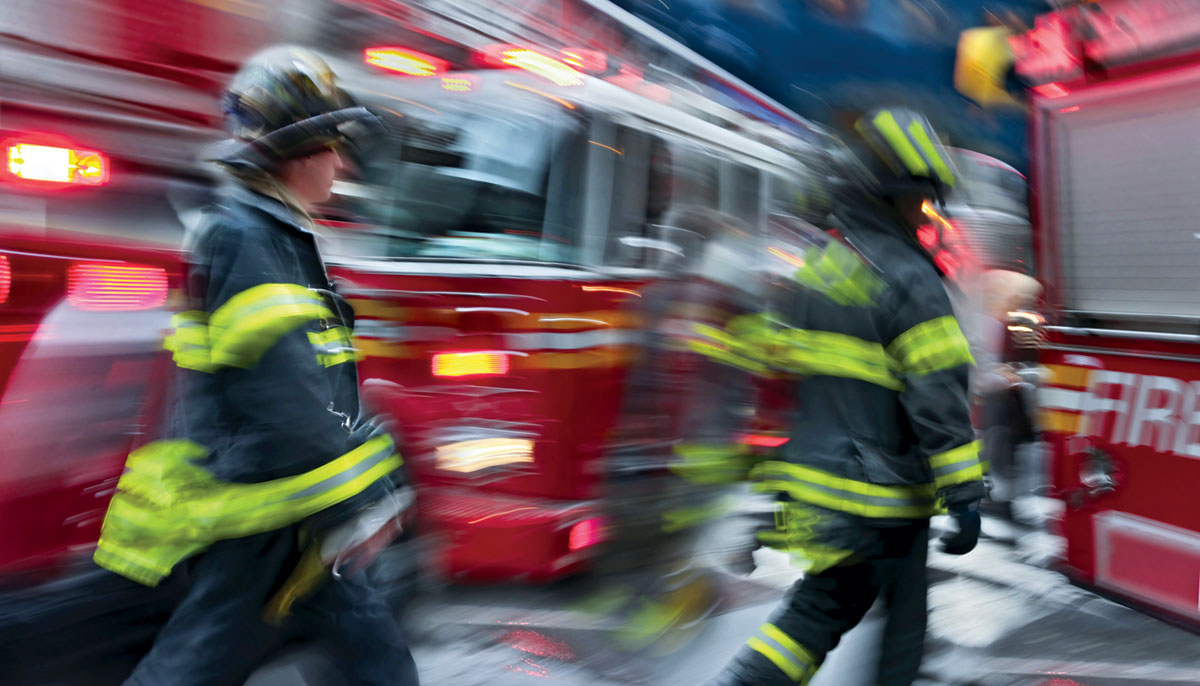On any emergency scene, I want to be calm. I want to be present, and I want to be creative. I want to be composed so that I—we—can see the problem and all possible solutions. I sometimes need out-of-the-box ideas, like how to disentangle a car from a bridge abutment or how to get a large man with intense back pain out of his bathroom and down three flights of stairs.
Being a firefighter has taught me that being efficient, curious, and creative are often as important as following the book.
To that end, firefighters have all sorts of tools—mental ones—to help find the “sweet spot” when we respond to an emergency scene.
I think you will find these tools useful in all sorts of situations when the goal is to stay calm and creative when everyone around you is losing their heads.
Pause, Breathe, and Take Your Pulse
REEEE! “Structure fire, flames showing. Possible explosion.”
When the pager goes off, the first thing I do is start breathing. It sounds simple, but deep, purposeful breathing is the pathway to calm.
Whether you are a Zen practitioner, a runner, a weight lifter, or a firefighter, controlling your breath is how you move from anxiety to performance, from tense to relaxed.
Take your own pulse before you take the pulse of a patient. Before acting, take a few seconds to calm down and slow down.
The overriding goal is to slow your breathing down and focus on four to six deep, slow breaths. I like to use “square breathing,” which is simple to remember:
1. Two seconds: inhale
2. Two seconds: hold your breath
3. Two seconds: exhale
4. Two seconds: hold
5. Repeat for four to six breaths
This is a skill we can practice regularly. Get up in the morning, square breathing. Stuck in traffic, breathe. Before you walk into your home after work (the whirling hour)… breathe. Once it becomes a habit, you’ll notice that after the first breath you’ll start to relax, your shoulders will drop, and you’ll be able to think more clearly.
This is just a way to follow the old fire-service cliché: Take your own pulse before you take the pulse of a patient. Before acting, take a few seconds to calm down and slow down.
These are great strategies in a crisis. Pause for a moment, take four to six deep breaths, take your own pulse, and you’ll be able to think more clearly and be more productive.
Repeat Mantras
Banging down a dirt road to a car crash, I can feel myself getting ramped up. Adrenaline flowing, my foot getting heavier on the gas pedal. Right about then, I repeat to myself my favorite mantras. They slow me down and help me think.
I believe in mantras—short memorized statements that help me stay calm and focused.
The first is simple: This is not my emergency.
When firefighters respond to a call, no matter how serious, we drum into our brains that—while this might be an emergency for the person, the patient, the owner of a house on fire—it isn’t our illness, injury, or home burning. We can be empathetic, but we don’t want to absorb and reflect back someone else’s panic. It’s not our emergency. It’s our job, we train for it, and most likely we’ve seen it or something like it before.
Similarly, when you are in a crisis situation, it’s essential to ask the question, “Whose emergency is this?”
The patients or the victims—the ones who are directly affected—this is their emergency. But it’s not for everyone else around them: family, friends, first responders, and even bystanders.
It is crucial to understand and define your role in a crisis. Is this your emergency or someone else’s? Are you the victim who needs help or is your role to solve the problem or provide support? I think of crises as the rock thrown in the pond, and the waves ripple outward in concentric circles. The individual or individuals who are the actual victims or patients are in the center of the circle. Everyone else is part of an outer circle with a different role; it is not their emergency. They are there to help, not to panic.
If it is not your emergency, pause, breathe, calm down, take your pulse first, and help solve the problem.
The second mantra is just as simple: Go slow to go fast.
When we rush, we make mistakes, and mistakes cost time. When I’m on a scene, especially a complex one, I repeat this endlessly. If I slow down, check that I have the right medication, make sure that I’ve grabbed the right end of a hose line (seriously), then I actually save time. Nothing is more frustrating than having to repeat steps because I’ve zoomed and forgotten something.
In a crisis, go slow when you can. Think about what you’re doing. Don’t scream out of the house to the hospital, forgetting your insurance card or to lock the house. It will save time: Go slow to go fast.
My third mantra is: Sick or not sick?
I use this mantra once I’ve arrived on the scene, when I need to step back and decide what’s most urgent. When we receive a 911 call, we’ve learned not to trust the information we get. It’s not the dispatcher’s fault, nor is it the caller’s. Instead, in an emergency, information often gets left out, garbled, ignored, or exaggerated, and what we’ve been told to expect isn’t always what we find at the scene. We roll into a call that went out as a cardiac arrest and are greeted by a talking and alert patient complaining of acid reflux.
We’ve learned to be suspicious of any call and to walk in with our eyes open.
Once we’ve determined that a scene is safe, we consider each person involved and ask, “Sick or not sick?”
“Sick” means an emergency; whether a person is suffering from trauma or an illness, we are going to transport them immediately. “Not sick” means someone has a problem, even an inconvenience, and we are going to remain on the scene, take our time, calm everyone down, and get to the bottom of what is going on. A “sick” patient might have chest pains, whereas a “not sick” patient might be an adult with a fever.
Use these mantras when something happens in your life: Is it your emergency or not? If not, calm down, and go slow to go fast. Then ask, Sick or not sick? Does something need immediate attention or can it wait?

by Hersch Wilson
Published by New World Library, 264 pages, paperback, $16.95
Turn On the Switch
All these tools—the discipline of breathing, taking your own pulse, and the mantras—are part of the firefighter mindset. When the pager rings out, the switch turns on and a normal dad becomes a firefighter.
But as I’ve gotten older, with grown-up kids, with elderly parents, and with the fraught politics we’ve inherited, that switch gets turned on in civilian life more and more. It’s useful: breathing, calming down, using those mantras. They work not only at a fire but when crisis hits our family or when the news (or Twitter) erupts with inflammatory events and opinions.
Most people never have to attack a house fire at 2 a.m., but we all have plenty of “fires” in our lives. That is as near a guarantee as the universe makes.
At a fire, firefighters automatically grab the tools off the engine that they know they will probably need: an ax, a pry bar, an SCBA (self-contained breathing apparatus). Yet in any difficult, stressful situation, we can always grab these mental tools: deep breathing, a calming mantra. Even repeating to yourself “I will not get upset” will do.
No one ever perfects this, but we can get better. The goal isn’t to become a Zen master, but to approach life’s emergencies with the intention to remain calm and act creatively.
Once we responded to a multiple-vehicle crash, with one car on top of another and another rolled over. Initially, as it often is in the beginning, everything was chaos. Then a paramedic stepped out of the ambulance, looked around, actually yawned, and sized up the scene. I remember wanting to be that calm, that composed. So I copied him. I stretched, put my hands in my pockets, and looked around. Then we went to work. I noted how just that one calm paramedic took all the anxiety out of the scene, and we got the job done effectively and with only a little craziness. He became my mental model for how to act.
From Firefighter Zen: A Field Guide to Thriving in Tough Timesby Hersch Wilson. Available August 18 from New World Library.

